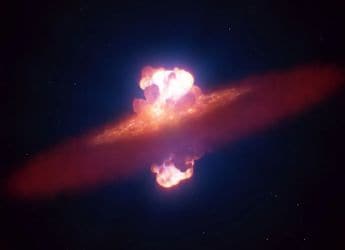- Home
- Science
- Science News
- Nasa Finds Most Luminous Galaxy in the Universe
Nasa Finds Most Luminous Galaxy in the Universe

The galaxy, known as WISE J224607.57-052635.0, belongs to a recently discovered new class of objects called extremely luminous infrared galaxies. Nasa said its dazzling light may be due to a behemoth black hole at its belly.
"Supermassive black holes draw gas and matter into a disk around them, heating the disk to roaring temperatures of millions of degrees and blasting out high-energy, visible, ultraviolet, and X-ray light," the space agency said in a statement.
The light, however, is absorbed by surrounding cocoons of dust, which prevents us from seeing the galaxy with optical telescopes.
When the dust heats up, it radiates infrared light, which was only now detected by the WISE telescope.
Because light from the galaxy hosting the black hole has travelled 12.5 billion years to reach us, astronomers are seeing the object as it was in the distant past, Nasa said.
At that time, our universe was only a tenth of its present age of 13.8 billion years but the black hole was already billions of times the mass of our sun, it said.
The new study, published in the Astrophysical Journal, also reported 19 other extremely luminous infrared galaxies.
Just like the most luminous galaxy found to date, these galaxies were not found earlier because of their distance, and because dust converts their powerful visible light into an incredible outpouring of infrared light.
Get your daily dose of tech news, reviews, and insights, in under 80 characters on Gadgets 360 Turbo. Connect with fellow tech lovers on our Forum. Follow us on X, Facebook, WhatsApp, Threads and Google News for instant updates. Catch all the action on our YouTube channel.
Related Stories
- Samsung Galaxy Unpacked 2025
- ChatGPT
- Redmi Note 14 Pro+
- iPhone 16
- Apple Vision Pro
- Oneplus 12
- OnePlus Nord CE 3 Lite 5G
- iPhone 13
- Xiaomi 14 Pro
- Oppo Find N3
- Tecno Spark Go (2023)
- Realme V30
- Best Phones Under 25000
- Samsung Galaxy S24 Series
- Cryptocurrency
- iQoo 12
- Samsung Galaxy S24 Ultra
- Giottus
- Samsung Galaxy Z Flip 5
- Apple 'Scary Fast'
- Housefull 5
- GoPro Hero 12 Black Review
- Invincible Season 2
- JioGlass
- HD Ready TV
- Laptop Under 50000
- Smartwatch Under 10000
- Latest Mobile Phones
- Compare Phones
- Vivo Y500 Pro
- Realme GT 8 Pro Aston Martin F1 Limited Edition
- Huawei Mate 70 Air
- Moto G57
- Moto G57 Power
- Motorola Edge 70
- Moto G Play (2026)
- Moto G (2026)
- MacBook Pro 14-inch (M5, 2025)
- Asus Vivobook S16 (S3607QA)
- iQOO Pad 5e
- OPPO Pad 5
- Noise Diva 2
- Noise Halo 2
- Acerpure Nitro Z Series 100-inch QLED TV
- Samsung 43 Inch LED Ultra HD (4K) Smart TV (UA43UE81AFULXL)
- Asus ROG Ally
- Nintendo Switch Lite
- Haier 1.6 Ton 5 Star Inverter Split AC (HSU19G-MZAID5BN-INV)
- Haier 1.6 Ton 5 Star Inverter Split AC (HSU19G-MZAIM5BN-INV)

















